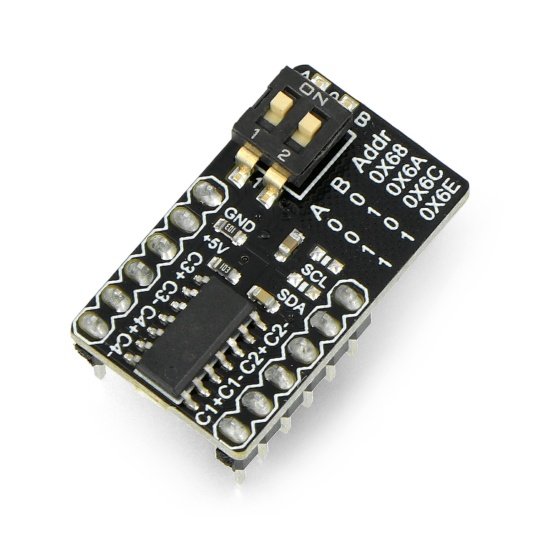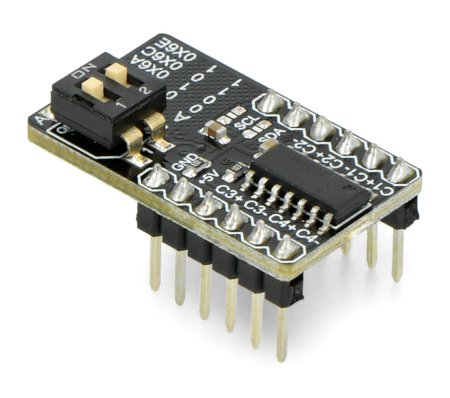Description
Module with analog-digital converter, delta-sigma type with 18-bit precision. It is equipped with four channels with differential inputs. It works at speed of up to 240 samples per second. It has the ability to change the amplification of: x1, x2, x8. It is supplied with the voltage from 2,7 V to 5,5 V, and communicates over I2C. The board consists of ferrite chokes which filter teh supply voltage.
For communication, it uses the popular I2C interface with a possibility to choose of one of the four available 7-bit addresses through a slide switch. Thanks to such solution, on one bus you can connect several converters. Check the documentation for details in the table 5.
The device has two modes of operation:
- One-Shot - converter performs a single conversion and returns to low power consumption mode until it doesn't get the command to do the next transformation.
- Continuous- conversion occurs continuously with the selected speed.
| The product is compatible with Arduino and Raspberry Pi
The manufacturer provides alibrary for the Raspberry Piandthe Arduino libraryalong with thedescription of the connection. |
Specification
- Supply voltage: 2,7 to 5,5 V
- Current consumption in standby mode: 300 nA (at 5 V)
- Number of inputs: 4
- Available reference voltage: 2,048 V ± 0.05 %, drift of 15 PPM /°C
- Programmable amplification (PGA): x1, x2, x4, x8
- Programmable resolution: 12, 14, 16, 18-bit
- Programmable conversion rate: 240, 60, 15, or 3.75 Sps
- Error of amplification: 0.05% (PGA=1,18-bit)
- Offset: 15 µV (PGA=1,18-bit)
- Communication interface: I2C
- Built-in pull-up resistors of the I2C bus line
- Operating temperature range: -40 °C to +125 °C
- Connectors: goldpin strips - pitch of 2.54 mm (soldered)
- Module dimensions: 27 x 16 mm
Pins
- SDA- data line of the I2C bus
- SCL - the clock line of the I2C bus
- +5V - supply voltage in the range from 2.7 to 5.5 V
- GND- ground of the system
- Cx+, Cx-differential inputs to connect the analog signal
Pins aregoldpin connector with the pitch of 2.54 mm. Thanks to them, it is possible to connect the system with the breadboardor the main module (e.g. Raspberry Pi orArduino) viawires.
Useful links |
















































































































































































































































































































































